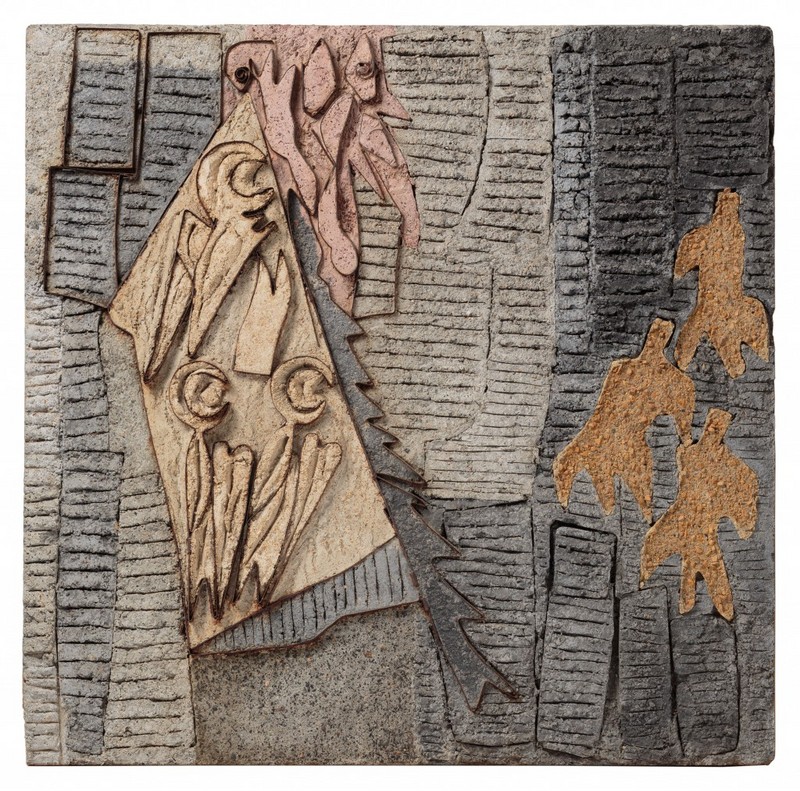Siri Derkert
13 Nov - 20 Dec 2014

Siri Derkert
Änglar och människor/Senapsträdet och himlens fåglar, 1961-1962
Carved concrete, steel sheet band
Photo: Jean-Baptiste, Beranger.
Änglar och människor/Senapsträdet och himlens fåglar, 1961-1962
Carved concrete, steel sheet band
Photo: Jean-Baptiste, Beranger.
SIRI DERKERT
13 November – 20 December 2014
Andréhn-Schiptjenko proudly presents the first extensive solo show with works by Siri Derkert. The opening takes place on Thursday, November 13, 5-8 pm.
Siri Derkert (1888–1973) is known for her highly personal expressionist style and for her monumental public commissions, often of a political nature. She is one of the few prominent female artists in Swedish art history. Her most well known works are perhaps “Carvings in Natural Concrete” at the subway station Östermalmstorg (1961-65) and “The Sweden Wall” (1967) on the wall of the Sweden House, both in Stockholm.
The exhibition at Andréhn-Schiptjenko focuses on Siri Derkert’s ardent interest in women’s liberation as well as environmental issues, two fields in which she was a forerunner and raised issues still relevant today. The selection of works shows her multi-faceted production during the 1950ies and 60ies and consists mainly of unique reliefs with carvings in coloured concrete, produced in connection with to two public commissions. The exhibition also presents drawings, sketches and reliefs made of steel sheet or band iron.
Two of the concrete reliefs are variations on motifs from the public commission “The Female Pillar”(1956-58) on the theme of women’s liberation, at T-Centralen subway station. A group of eight reliefs were produced in connection with the work “The Mustard Tree and the Birds of Heaven”(1961-62) consisting of a montage of coloured concrete and steel sheet band squares with bird and tree symbolism, placed in Skövde kulturhus.
A third group of works show a recurrent theme in Derkert’s œuvre; the participants at The Women’s College for Civic Training at Fogelstad (1925-54). The group, to which Siri Derkert was closely attached from 1943, offered practical citizenship education to women engaged in the movement for women’s suffrage. The Fogelstad choir, lead by the musician Elsa Stenhammar, is the single most frequent motif in Derkert’s Fogelstad works. A selection of these works will be exhibited, among which a work in concrete, showing Stenhammar by the piano.
Siri Derkert represented Sweden in the Nordic Pavilion at the Venice Biennale in 1962 and had an extensive retrospective exhibition at the Stedelijk Museum in Amsterdam the same year. Her works have been shown in two retrospectives at the Moderna Museet in Stockholm (1960 and 2011). Derkert’s works can be found in many Swedish museums, among them Nationalmuseum, Stockholm, Moderna Museet, Stockholm, Malmö Art Museum, Gothenburg Museum of Art, Skövde Art Museum and the Museum of Sketches, Lund. In 2013, Andréhn-Schiptjenko showed a small presentation of Derkert’s band iron reliefs and the same year Swedish Television broadcasted the documentary “Siri Derkert – I was impossible”.
13 November – 20 December 2014
Andréhn-Schiptjenko proudly presents the first extensive solo show with works by Siri Derkert. The opening takes place on Thursday, November 13, 5-8 pm.
Siri Derkert (1888–1973) is known for her highly personal expressionist style and for her monumental public commissions, often of a political nature. She is one of the few prominent female artists in Swedish art history. Her most well known works are perhaps “Carvings in Natural Concrete” at the subway station Östermalmstorg (1961-65) and “The Sweden Wall” (1967) on the wall of the Sweden House, both in Stockholm.
The exhibition at Andréhn-Schiptjenko focuses on Siri Derkert’s ardent interest in women’s liberation as well as environmental issues, two fields in which she was a forerunner and raised issues still relevant today. The selection of works shows her multi-faceted production during the 1950ies and 60ies and consists mainly of unique reliefs with carvings in coloured concrete, produced in connection with to two public commissions. The exhibition also presents drawings, sketches and reliefs made of steel sheet or band iron.
Two of the concrete reliefs are variations on motifs from the public commission “The Female Pillar”(1956-58) on the theme of women’s liberation, at T-Centralen subway station. A group of eight reliefs were produced in connection with the work “The Mustard Tree and the Birds of Heaven”(1961-62) consisting of a montage of coloured concrete and steel sheet band squares with bird and tree symbolism, placed in Skövde kulturhus.
A third group of works show a recurrent theme in Derkert’s œuvre; the participants at The Women’s College for Civic Training at Fogelstad (1925-54). The group, to which Siri Derkert was closely attached from 1943, offered practical citizenship education to women engaged in the movement for women’s suffrage. The Fogelstad choir, lead by the musician Elsa Stenhammar, is the single most frequent motif in Derkert’s Fogelstad works. A selection of these works will be exhibited, among which a work in concrete, showing Stenhammar by the piano.
Siri Derkert represented Sweden in the Nordic Pavilion at the Venice Biennale in 1962 and had an extensive retrospective exhibition at the Stedelijk Museum in Amsterdam the same year. Her works have been shown in two retrospectives at the Moderna Museet in Stockholm (1960 and 2011). Derkert’s works can be found in many Swedish museums, among them Nationalmuseum, Stockholm, Moderna Museet, Stockholm, Malmö Art Museum, Gothenburg Museum of Art, Skövde Art Museum and the Museum of Sketches, Lund. In 2013, Andréhn-Schiptjenko showed a small presentation of Derkert’s band iron reliefs and the same year Swedish Television broadcasted the documentary “Siri Derkert – I was impossible”.
